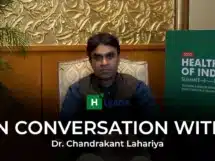There’s a high possibility of more than one vaccine for COVID-19. Yet, the best-case scenario is vaccine deployment by 2021, says Dr. Katherine O’Brien, WHO’s Director, Department of Immunization, Vaccines & Biologicals.
“I don’t think any part of our lives is ever going back to pre-COVID,” says Dr. Katherine O’Brien, WHO’s Director, Department of Immunization, Vaccines & Biologicals in an exclusive online interview with HealthLEADS.
As the scientific world races to find a vaccine against a disease that has, within months, infected millions and killed hundreds of thousands across the globe, public health infrastructures across the globe are being tested to their limits. “People have been enormously participatory in protecting each other…But I think we all want to get back to a life that doesn’t require us to shelter in place and have physical distancing (as the norm),” notes the Professor at the Johns Hopkins Bloomberg School of Public Health (JHSPH).
Here are the edited excerpts of Dr. Katherine O’Brien’s insightful take on the global race for COVID-19 vaccine, growing medical misinformation, the role of journalists, and more:
Did we foresee this pandemic?
The WHO and many experts have been speaking about this for quite a number of years. So, yes, we saw it coming. We didn’t know when, and we didn’t know what, and we didn’t know the specific nature of it. But we knew something like this was highly likely, if not certain, to happen.
We’ve seen episodes of germs having moved from animals to humans. Where we don’t have immunity as a world to these pathogens, they would move from person to person, and from the community to community. They would cross borders and they would spread around the world. You couldn’t look at the evidence of virology and other pathogens, and not see that as a possibility. And we’d experienced it before. Probably the most recent example was the 1918-1919 influenza pandemic. In fact, the scientific world was calling on countries to prepare, to ready ourselves, so that we could stop it as quickly as possible and mitigate the impact of it as best as could be done.
How is the global effort to find a COVID-19 vaccine doing so far?
Every institution that touches the possibility of a vaccine has turned over its primary focus, its energy, its time, its money to finding a COVID-19 vaccine, or vaccines. We believe there will be more than one that will come forward. So, the effort, the coordination, the collaboration are unprecedented, really. Because the whole world is feeling this and the impact is across families, communities, and age groups. There is no sector that has been left out of this. And the urgency to move along with safety and with science and with data-driven decisions is paramount.
There are different categories of vaccines that are being developed. Some of these have never been developed as vaccines previously, like the DNA-based and the mRNA-based vaccine. There are big advantages to those types of vaccines if they work. That’s part of the reason there’s so much interest in them – the ability to scale and produce them rapidly. We have to recognise we will likely have more than one COVID vaccine, and they will likely be using different approaches to vaccination.
What’s the best- and worst-case scenario for the COVID vaccine?
The best-case scenario is that by the mid-fall, we have at least one product that has been shown to be safe and effective against COVID-19. And that we have a mechanism to actually allocate that vaccine; we’ve got the manufacturing capacity to develop hundreds of millions, perhaps, billions of doses that would be needed; and we are moving quickly along to start to deploy that vaccine by 2021.
The worst-case scenario, I think, is where we have neither diagnostics nor treatments, nor a vaccine, and that we’re still in a state where we have to use what we would call ‘epidemiologic principles’ to control the pandemic. I don’t think that’s where we will be. That’s a complete pessimist’s view. I do think we’re going to have a much greater diagnostic capacity. We will continue to apply the strategies and techniques that are being used now and successfully used, to shift this pandemic.
What is WHO’s role in the vaccine development process?
WHO plays a critical role across the vaccine value chain. A vaccine has to go from discovery, development, testing, through to an evaluation of the evidence from that testing, which results in licensure, and a regulatory process, so that every country can decide whether or not those vaccines are ones that they want to work with and to import. It also means that there has to be a policy – who should get this vaccine? What should be the order of people getting the vaccine? How will the vaccine be allocated across countries? Are countries going to agree to an allocation framework? And finally, there has to be manufacturing, supply, the shipment of vaccines, and country implementation.
My department, which is the Department of Immunization, Vaccines & Biologicals, largely works across that value chain, but primarily on the policy side, the strategy side of a vaccine, the country implementation, the readiness of a country to implement, and the evidence around what vaccine we should be using, and what the order of vaccination should be – what would be the highest priority groups who should receive those vaccines?
We’re working in collaboration through the ‘Act Accelerator’ to assure that we have agreements, mechanisms, and structures in place so that when vaccines are developed, equitable access is the principle that is used to allocate vaccines. And there are financing mechanisms to assure that those countries that are least able to pay, have the ability to actually secure the supply of their vaccines for the people in their country. There is no interest in vaccinating only certain people in certain countries. This virus anywhere is this virus everywhere. And so everybody has an interest in shutting down this pandemic. And to do that, we require interventions everywhere where the virus is. We all have an equal interest in that.
How is the vaccine development of COVID-19 different from past vaccine developments?
Past vaccine developments have always centred on the health need for a vaccine. That’s what really drives the decision to pursue a vaccine. For COVID-19, the difference is the coordination and speed with which the attention and efforts are being made to pull all of the pieces together. And normally we work in series – we first develop evidence around the burden of disease, manufacturers, scientists, academics, the whole discovery enterprise works on trying to understand the genetics of a pathogen or the biology of the pathogen. And then, we move stepwise towards vaccine development. Until we actually have a vaccine that is likely to be licensed, we do not begin the policy process. And until the policy process has ended, we do not start to implement the processes for countries to move forward with the vaccine.
Some of the lessons, not only from COVID, but from Ebola vaccine development, and other vaccines that have come along, are about how can we go more quickly, leverage more resources, and yet maintain the highest level of assurance of safety, impact, and efficacy.
How broad and adaptable is the vaccine development right now, so that newer strains and mutations are accounted for?
Every genetic organism goes through changes in its genetic makeup. That’s the nature of biology. The question is not whether or not this virus is changing. The question is: Are those changes relevant for vaccine development? And the scientific community is watching this very closely and at this point, the targets for vaccine developments don’t seem to be compromised by the changes that are happening. Remember, we’ve only had the genetic code to this virus since early this year. So this is going at an unprecedented pace and has to be watched over time.
Is there a plan B in case there is no COVID vaccine?
There’s no vaccine until there’s a vaccine. We have many pathogens where we’ve been working to develop a vaccine for many years – HIV is an example. There has been a 30-year effort to develop HIV vaccines. And so, there’s no endpoint where you say it’s impossible to develop a vaccine against this. There’s the accumulation of new knowledge, innovation, new ideas about how to approach the problem. It’s not a static field. We have no guarantee that there will be a successful, safe vaccine. There is no crystal ball on that. However, we do know that the more shots on goal that you have, the more vaccines candidates that come forward, the better chance there is that one of them, or more than one of them, will be successful. And success is defined not just by being able to prevent disease, but also by being safe.
This is already the third coronavirus outbreak in the last two decades. Like the influenza pandemics of the past, do we see the possibility of coronaviruses causing more pandemics?
I don’t think we should overstep the analogy between influenza virus, a very special virus that does shift and drifts in its genetic makeup, and coronavirus, a known cause of upper respiratory tract infections and of lower respiratory tract infections that can be more serious. We’ve seen the emergence of some new coronaviruses, new to humans, that have not been infecting humans before, or that we’re able to detect them now, whereas perhaps previously we didn’t have the surveillance and the means to detect them when they would emerge.
The question today is, whether or not the coronavirus will modify in adaptation to immune pressure from its human transmission to a point where it will escape from whatever immunity is developed. Whenever a pathogen changes its genetic makeup, it can be adaptive and it can be maladaptive. It actually can be a shift that is not very advantageous for the organism, and it can no longer be as infectious/harmful to humans.
How are you addressing the problem of vaccine hesitancy or anti-vax that reduces the efficacy of public vaccination programmes?
We’re absolutely concerned. First of all, about what’s happening on social media – the misinformation, inaccurate information, and outright falsehoods around both COVID vaccines as well as other licensed and well-evaluated vaccines that have demonstrated safety and impact. We are concerned that people will take on board information that is not correct and as a result may make decisions that are not in their interests from a health perspective. We’re watching, and we’re responding with our colleagues in social media companies that when misinformation is circulating, it will be taken down. It is not of benefit for anybody for falsehoods to be distributed.
WHO has termed COVID-19 as an infodemic of misformation. Is the problem affecting scientific research too?
The processes we have for science and for vetting of information are very solid. I’m sure a lot of your readers have read about ‘peer-review’. What it means is that when scientists write a paper or come up with a finding, they actually need to have their work reviewed by other people who are experts in the field. If those critiques find that the work did not follow valid scientific approaches, then either the work is not published, or the work has to be rewritten or re-described to meet the standards that we have in the scientific world.
What’s happening now is that many pieces of work are being put out there without having been reviewed by people who are not involved in the work. While it’s good to put things out there as quickly as possible, we must recognise that these pieces of work have not been reviewed by our peers and there may be some very serious flaws in the work. It’s extremely important that we protect that process in the scientific domain and in the way in which scientific work is published. I think we can rely on the highest standards of work, especially those works that are published in journals that demand the highest standards. Not all journals require that. There is no report in science where we say that is the final truth, it’s the only truth. And because there is variability in biology, an observation in one place, in one time, among one group of people, may not be repeatable. It may not be a general truth, it may be an outlier.
Most people among the general public don’t read scientific literature. But journalists – and rightly so – are translating what they’re reading in scientific journals and putting that out in ways that the general public can absorb. Unfortunately, some parts of the media are looking for sensationalist stories. They are not actually looking for credible, valid information. They’re looking for the thing that is going to spark fear or spark outrage. That is not helpful, especially when it is obvious that those reports are grounded in falsehoods. So I think that it is really important that journalists hold themselves to the highest standards that they possibly can, and that they look for credible, vetted, scientific information, and not sensationalism.

















